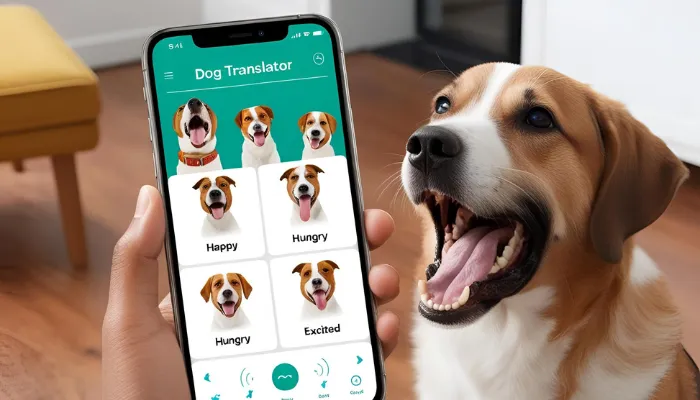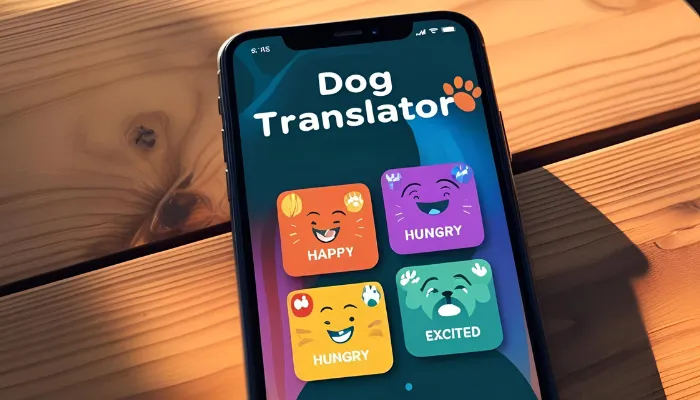Dog translator online devices claim to bridge the communication gap between humans and their furry companions. Most pet owners want to connect better with their pets, and as technology advances, translators have emerged that interpret a dog’s bark and convert human speech into canine language.
But how reliable are these tools? Can a human to dog translator truly help strengthen our bond with our pets?
This article will discuss the different kinds of dog language translator tools, dog translator app options, and whether we can actually talk in dog language. In addition, we will look at how dogs speak, the best translation tools in the world, and other ways to understand your pet better.

Dog Translator: What is it?
A dog translator is a tool designed to convert human speech into sounds that dogs might understand. Some versions claim to analyze dog barks and translate them into human language, allowing us to understand what our pets are trying to communicate.
There are different types of dog language translators:
- Dog bark translators: These analyze a dog’s vocalizations to determine its emotions and intent.
- English to dog translators: These attempt to convert human speech into dog-friendly sounds.
- Dog translator apps: Digital tools available for smartphones to help humans interpret their dog’s language.
While these translators sound exciting, they have limitations. The accuracy of these tools is still debated among scientists and pet behaviorists. Since dogs rely on a combination of vocalizations, body language, and context, no tool can fully translate their communication.
How Do Dog Translation Apps Work?
Many dog translator apps claim to help people understand their pets. They work in two main ways:
- Human to Dog Translation: Converts human speech into barks or whines.
- Dog Bark Analysis: Analyzes different dog sounds and suggests their meanings.
Human to Dog Translation
These applications often try to include barking sounds that are regarded as greeting. For instance, if a user uses the phrase “hello,” they might get a simulated barking that serves as a greeting. Given that dogs communicate largely using body language and tone, these translations are a stretch of the scientific approach.
Some apps also use sound boards, enabling users to press buttons marked with images of dogs. While this is entertaining, its effectiveness mainly rests on the temper and training of the dog in question.
Dog Bark Analysis
There are some dog translator apps that try to analyze barks to determine how your pet dog feels. They tend to classify barks into the following categories:
- Pitch: High-pitched barking in dogs is done when they are very happy or excited. On the other hand, danger note barking is done in a low tone.
- Frequency: Multiple barks suggest impatience, while a single bark could show that the dog is curious or alert.
- Duration: Final long-drawn out howls may indicate the state of loneliness or something that is utmost distressing.
- Context Recognition: Some applications seek to evaluate the sounds of the surrounding environment and the context of the barking.
Are These Apps Accurate?
You cannot take dog translation apps seriously, although they are entertaining. Most experts agree that dogs have a unique set of vocalizations, but that their communication is embedded within the context of their environment and their body language.
It is important to remember that these apps may come across as entertaining, but they do not understand your dog’s behavior. If someone is truly serious about conversing with their pet, an app is never as effective as learning canine nonverbal communication and spending time with your dog.
How Do Dogs Communicate?
Dogs don’t use words, but they have their own way of expressing themselves. So, do we really need a dog translator? Their communication relies on:
- Vocalizations: Barks, whines, howls, and growls all have different meanings.
- Body language: Tail position, ear movement, and facial expressions reveal emotions.
- Scent and touch: Dogs use scent marking and physical contact to communicate.
Common Dog Barks and Their Meanings:
- Short, high-pitched bark: Excitement or greeting.
- Repetitive barking: Alarm or warning.
- Growling: Fear, discomfort, or aggression.
- Whining: Anxiety, submission, or a request for attention.
- Howling: Communication with other dogs or loneliness.
Understanding these cues helps owners interpret their dog’s emotions better. Pairing vocalizations with body language analysis provides a clearer understanding of what your dog is trying to express.
Benefits of Using a Dog Translator Online
Engaging with your pet can be fun using a dog translator online. Though these devices may not offer perfect translations, they provide advantages such as:
- Strengthens Bonding: Using a translator can allow for engaging interactions and therefore strengthen your relationship with the pooch.
- Encourages Learning: Helps owners to be more mindful and attentive towards their dog’s sounds and actions.
- Provides Entertainment: Enjoyable for families and children for trying out various sounds.
- Supports Training Efforts: Some applications provide positive reinforcement techniques that help in command training.
- Accessible and Easy to Use: Dog translators can conveniently be found online, from websites and mobile apps.
Dog translators, as interesting as they may be, are not meant as a substitute for real engagement with your animal which comes from training, observation, and bonding.

Best Online Human to Dog Translators
Several human to dog translator tools exist online. Here are some of the best options:
Free Options:
- Dog Translator Online – A web-based tool that converts words into barking sounds. Users can enter phrases, and the tool generates a simulated bark in response. While fun, these translations may not accurately reflect true canine communication.
- Human-to-Dog Soundboard – This interactive tool lets users play various barking noises to engage with their dogs. It can be useful for training or simply entertaining your pet, though the effectiveness varies based on individual dog responses.
Paid Options:
- BowLingual Dog Translator – A specialized device that claims to analyze dog barks using AI-driven pattern recognition. It categorizes vocalizations into different emotional states such as happiness, frustration, or curiosity.
- Dog Bark Analyzer Pro – A mobile app designed to detect and categorize different bark patterns, helping owners understand whether their dog is alert, anxious, or excited. The app also provides training tips based on detected sounds.
- Puppy Talk Translator – Another paid app that converts human words into barking sounds and attempts to match different tones to dog-friendly communication.
While these tools can be entertaining, they should be used alongside real training and observation for the best results.

Top Dog Translator Apps You Can Try
Looking for a dog translator app? Here are some of the most popular ones:
| App Name | Features | Pros | Cons |
|---|---|---|---|
| Dog Translator Simulator | Simulates dog sounds based on human words. | Fun and interactive. | Not scientifically accurate. |
| Human to Dog Translator (iOS/Android) | Offers a variety of barking sounds. | Allows user testing of different sounds. | No real-time analysis of dog’s barks. |
| Talk to Your Dog App | Translates human voice into dog-friendly tones. | Some dogs react positively. | Not a true translation tool. |
| Pet Translator: Dog & Cat Speak | Supports multiple pet sound translations. | Works for dogs and cats. | Limited accuracy. |
| Dog Speak Translator | Uses AI to mimic dog sounds for interaction. | Provides educational tips. | Entertainment-focused rather than scientific. |
These apps provide an engaging way to interact with dogs, but they do not replace real understanding. Observing your dog’s body language and vocal patterns remains the most effective way to communicate.
Can You Really Translate English to Dog Language?
Many pet owners wonder if they can use an English to dog translator to speak directly to their pets. Unfortunately, dogs don’t understand human words the way we do.
However, they do recognize:
- Tone of voice (angry, happy, calm).
- Repetitive commands (such as “sit” or “stay”).
- Gestures and body language.
Rather than relying on a translator, training your dog using positive reinforcement is more effective. Dogs learn through association, meaning they connect words with actions and consequences. For instance:
- Saying “sit” while guiding your dog into a sitting position and rewarding them reinforces the command.
- Using a cheerful voice when calling them increases the chances of a positive response.
- Raising your hand in a “stop” gesture can help reinforce boundaries.
How Dogs Process Human Speech:
Studies suggest that dogs process human speech similarly to how we do. They differentiate between words and intonation, relying on both to understand commands. While they may not grasp complex sentences, they can learn to associate specific words with actions or rewards.
Can Dogs Learn a Large Vocabulary?
Some highly trained dogs can understand over 100 words. Breeds like Border Collies, German Shepherds, and Poodles tend to have excellent learning abilities. Through consistent training, patience, and reinforcement, you can expand your dog’s vocabulary.
Why Body Language Matters More Than Words?
Dogs rely more on body language than verbal communication. A confident stance, eye contact, and relaxed movements help convey your intentions. Misalignment between words and gestures can confuse them—for example, if you say “stay” but move away nervously, your dog may misinterpret the command.
Understanding your dog’s cues and using consistent training will strengthen your bond more than any dog translator ever could.

How to Communicate in Dog Language?
How to speak dog language translator tools may seem helpful, but effective communication with your dog begins with recognizing their cues and responding appropriately. But do you really need a dog language translator? Remember to always do the following.
- Use consistent commands: Dogs learn better from repetition.
- Consider your tone of voice: Happy tone lifts spirits and stern voice tells one off.
- Body language comes into play: Use relaxed gestures. Avoid threatening postures.
- Utilize rewards to reinforce positive behavior: Treats and praise help in better behavior.
- Make eye contact: Soft eye contact helps build trust while direct eye contact hinders it.
- Understand calming signals: Lip licks, yawns, or looking away suggest that the dog is uncomfortable.
- Know about the breeds: While some breeds are more vocal, others rely on body language.
- Join in for some fun time: During playtime, your relationship is strengthened and communication is enhanced.
- Be persistent: Dogs prefer swift, consistent, and positive reinforcement over an extended duration.
Watching your dog’s behavior and following these habits will help build a stronger connection with your dog through enhanced communication skills.
Myths vs. Facts About Dog Bark Translators
Many pet owners wonder if dog bark translator can truly decode their pet’s thoughts, but the reality is more complex.
Myth 1: Dog Translators Can Speak for Your Dog
Fact: No device can perfectly translate a dog’s thoughts.
Myth 2: Bark Translators Are 100% Accurate
Fact: Barking varies based on context, making exact translations difficult.
Myth 3: You Don’t Need to Learn Dog Behavior if You Use a Translator
Fact: Even with technology, understanding dog body language is crucial.
While technology can offer insights, nothing replaces the deep bond formed through understanding your dog’s natural communication.

Troubleshooting Communication Challenges with Dogs
It may seem like communicating with your dog is like trying to solve a missing puzzle piece. Since dogs do not speak a human language, they try to convey their feelings through body movement, barks, and actions. Dog translator? It can be frustrating if messages aren’t passed properly, but building trust enables effective communication. Here is how to overcome common issues:
Common Communication Challenges
- Misinterpreting Body Language: A tail that is wagging and making motion up and down is not always a sign of happiness, it may also indicate fear or tension.
- Ignoring Vocal Cues: Different kinds of barking, whining, or growling have different cues.
- Inconsistent Commands: Giving dogs varying commands that require the same outcome is very confusing.
- Lack of Attention: Dogs sometimes tend to become aware if you are not fully focused on them, also making it challenging for them to concentrate.
- Overwhelming Your Dog: Stress may occur if many commands or stimuli are given at once.
How to Fix Communication Issues?
- Learn Body Language:
- Ears in a back position suggest fear or relaxation.
- Stress or tiredness may be indicated by yawning.
- A wagging tail may indicate happiness or anxiety.
- Understand Vocalizations:
- Low growls from a dog suggest they are uncomfortable.
- An anxious dog will often whine in order to grab attention.
- An excited dog will bark in high pitch.
- Be Consistent: Make use of the same phrases and body language gestures for instructions.
- Use Positive Reinforcement: Good deeds should be rewarded by giving them a treat or edification.
- Minimize Distractions: Train in a calm setting.
- Try a Dog Translator App: Devices such as a dog bark translator or human to dog translator can be interesting and revealing.
When to Seek Help:
It is critical to seek the help of a professional trainer or behaviorist if your dog exhibits aggression, severe anxiety, or has persistent behavioral issues.
Fun Ways to Improve Communication:
- Have fun with interactive games like fetch and hide-and-seek.
- Teach him new tricks as a way to gain his trust.
- Have some dialogues using a dog translator app for entertainment.
- Go for strolls in unfamiliar environments.
Improving communication with your dog takes practice and commitment. It doesn’t matter whether you are using a dog translator app, interpreting barks, or watching his body movements, knowing how your dog communicates will strengthen the bond between you and your canine friend. So, what are you waiting for? Start today to enjoy a happier and more connected relationship with your furry buddy.
Alternative Ways to Communicate with Your Dog
Communication with your dog involves more than talking as their signals are crucial and bonding techniques enhances the relationship.
- Hand Signals: Some dogs understand specific pointing or hand movement better than words.
- Clicker Training: A learning reinforcement technique where a clicking sound is used to mark desired behavior.
- Training Commands: Only a descriptive and basic term should be used with your dog in order for them to complete the action.
- Observing Body Language: Understanding how to interpret the position of a dog’s tail, ears and overall posture.
- Consistent Tone of Voice: Calm and audible command everything is, you will be happy in return, so praise.
- Interactive Play: Strengthening interaction through fetch or hide-and-seek and the like.
- Daily Training Sessions: Sticking to short and consistent training garners trust building, and understanding.
With these tools, you can nurture your relationship with your dog without depending on advanced technology to communicate effectively.
FAQs About Dog Translators
Curious about how dog language translator apps and human to dog translators work? Here are some frequently asked questions!
1. Do dog translators really work?
Dog translators offer an amusing experience, but they are not scientifically valid because dogs talk via body movements, tone, as well as context.
2. Can I translate English to dog language?
Although there are apps that can bark, they do not have the real ability to communicate as a real dog employs proper training and his body along with its vocal cords to speak.
3. What’s the best way to understand my dog?
Listening to barks, watching tail action, ear position, and general activity all contribute toward effectively ascertaining a dog’s feelings and needs.
4. Are there any scientifically-backed dog translator apps?
Most of them are for fun, although a few like BowLingual claim that they can analyze barks through AIand their accuracy is contentious.
5. How can I improve communication with my dog?
For greater communication, using clear commands, praise, and training are far more effective than any tool for translation.
Understanding your dog takes patience and observation, but the bond you build is far more rewarding than relying on an app!
Conclusion
Dog translator apps may seem helpful, but they aren’t entirely accurate or realistic when it comes to communication. Since dogs rely on barks, body language, and tone to express emotions, true translation simply isn’t possible. So, can a dog translator online really help?
Instead of solely being dependent on apps, that’s where training, observation, and interaction come into play to understand your furry friends more thoroughly. Noticing vocalizations, gestures, and context helps create a stronger bond with your pet. While a human to dog translator or a dog language translator may seem convenient, real communication comes from understanding your dog’s natural signals.
At the end of the day, to genuinely connect with your dog, consistent communication, patience, and positive reinforcement will get you there without a dog translator app.
